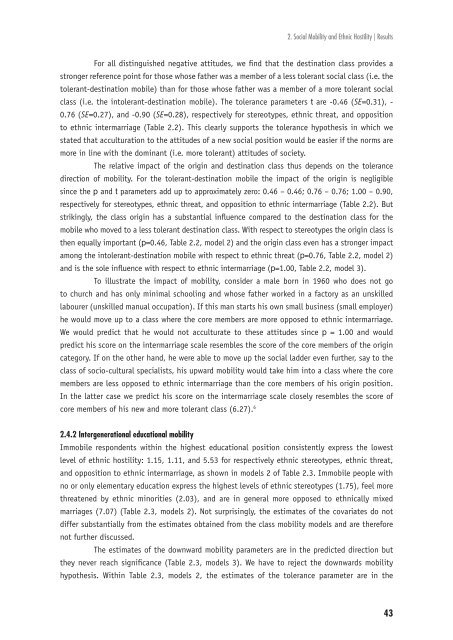Ethnic Hostility among Ethnic Majority and Minority Groups
Ethnic Hostility among Ethnic Majority and Minority Groups
Ethnic Hostility among Ethnic Majority and Minority Groups
Create successful ePaper yourself
Turn your PDF publications into a flip-book with our unique Google optimized e-Paper software.
2. Social Mobility <strong>and</strong> <strong>Ethnic</strong> <strong>Hostility</strong> | Results<br />
For all distinguished negative attitudes, we fi nd that the destination class provides a<br />
stronger reference point for those whose father was a member of a less tolerant social class (i.e. the<br />
tolerant-destination mobile) than for those whose father was a member of a more tolerant social<br />
class (i.e. the intolerant-destination mobile). The tolerance parameters t are -0.46 (SE=0.31), -<br />
0.76 (SE=0.27), <strong>and</strong> -0.90 (SE=0.28), respectively for stereotypes, ethnic threat, <strong>and</strong> opposition<br />
to ethnic intermarriage (Table 2.2). This clearly supports the tolerance hypothesis in which we<br />
stated that acculturation to the attitudes of a new social position would be easier if the norms are<br />
more in line with the dominant (i.e. more tolerant) attitudes of society.<br />
The relative impact of the origin <strong>and</strong> destination class thus depends on the tolerance<br />
direction of mobility. For the tolerant-destination mobile the impact of the origin is negligible<br />
since the p <strong>and</strong> t parameters add up to approximately zero: 0.46 – 0.46; 0.76 – 0.76; 1.00 – 0.90,<br />
respectively for stereotypes, ethnic threat, <strong>and</strong> opposition to ethnic intermarriage (Table 2.2). But<br />
strikingly, the class origin has a substantial infl uence compared to the destination class for the<br />
mobile who moved to a less tolerant destination class. With respect to stereotypes the origin class is<br />
then equally important (p=0.46, Table 2.2, model 2) <strong>and</strong> the origin class even has a stronger impact<br />
<strong>among</strong> the intolerant-destination mobile with respect to ethnic threat (p=0.76, Table 2.2, model 2)<br />
<strong>and</strong> is the sole infl uence with respect to ethnic intermarriage (p=1.00, Table 2.2, model 3).<br />
To illustrate the impact of mobility, consider a male born in 1960 who does not go<br />
to church <strong>and</strong> has only minimal schooling <strong>and</strong> whose father worked in a factory as an unskilled<br />
labourer (unskilled manual occupation). If this man starts his own small business (small employer)<br />
he would move up to a class where the core members are more opposed to ethnic intermarriage.<br />
We would predict that he would not acculturate to these attitudes since p = 1.00 <strong>and</strong> would<br />
predict his score on the intermarriage scale resembles the score of the core members of the origin<br />
category. If on the other h<strong>and</strong>, he were able to move up the social ladder even further, say to the<br />
class of socio-cultural specialists, his upward mobility would take him into a class where the core<br />
members are less opposed to ethnic intermarriage than the core members of his origin position.<br />
In the latter case we predict his score on the intermarriage scale closely resembles the score of<br />
core members of his new <strong>and</strong> more tolerant class (6.27). 6<br />
2.4.2 Intergenerational educational mobility<br />
Immobile respondents within the highest educational position consistently express the lowest<br />
level of ethnic hostility: 1.15, 1.11, <strong>and</strong> 5.53 for respectively ethnic stereotypes, ethnic threat,<br />
<strong>and</strong> opposition to ethnic intermarriage, as shown in models 2 of Table 2.3. Immobile people with<br />
no or only elementary education express the highest levels of ethnic stereotypes (1.75), feel more<br />
threatened by ethnic minorities (2.03), <strong>and</strong> are in general more opposed to ethnically mixed<br />
marriages (7.07) (Table 2.3, models 2). Not surprisingly, the estimates of the covariates do not<br />
differ substantially from the estimates obtained from the class mobility models <strong>and</strong> are therefore<br />
not further discussed.<br />
The estimates of the downward mobility parameters are in the predicted direction but<br />
they never reach signifi cance (Table 2.3, models 3). We have to reject the downwards mobility<br />
hypothesis. Within Table 2.3, models 2, the estimates of the tolerance parameter are in the<br />
43












